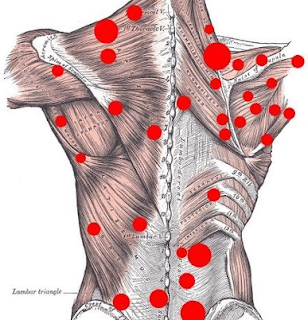Myofascial Pain Syndrome At A Glance
If described in general and brief, fibromyalgia pain is felt throughout the body by way of spreading, whereas myofascial pain syndrome is specific to the muscle or muscle group. Sometimes it can be difficult to keep track the exact muscle or group of muscles that cause pain when without some knowledge of the trigger point.
Myofascial Pain Syndrome Symptoms
The main symptoms of myofascial syndrome pain are the trigger points that are located beneath skin causing an extreme sensitivity and tenderness to the touch. These trigger points are very similar in nature to the tender points that most individuals with fibromyalgia experience and cause pain in the muscles when touched that is typically experienced the mostly in the area of the jaw, however, can occur in any part of the body.
This pain can also produce numerous other symptoms that may seem unrelated and include problems with balance, migraine headaches, muscle weakness, blurred or double vision, memory problems, and difficulty sleeping generally caused by the pain.
Specifically myofascial syndrome pain is experienced as a dull ache, however, it may also feel like a burning sensation, stabbing pain, or throbbing. Environmental conditions that can affect myofascial syndrome include changes in the weather such as dampness, cold, humidity, and dryness.
Activity of physical can also cause an increase of symptoms as well as anxiety and stress. The symptoms of MPS are so similar to the symptoms experienced by those with fibromyalgia that at one time it was believed that this condition was actually a form of fibromyalgia; therefore, MPS often goes misdiagnosed as it is thought to be a symptom of fibromyalgia.
Myofascial Pain Syndrome Relief
There are many treatments for fibromyalgia and myofascial pain syndrome even though many of the available treatments and pain relief methods are rarely prescribed. Not only does it include a range of different herbal remedies and other natural treatments which many patients have found to be highly effective in alleviating certain of their symptoms, but also a variety of dietary and hormonal supplements and natural compounds can be highly effective.
The different types of non-medicinal pain relief which are available, meanwhile, range from the truly ancient to the truly modern. Treatments such as acupuncture and hydrotherapy often prove just as effective today as they did centuries ago for a variety of conditions, and many fibromyalgia and myofascial pain syndrome patients find them highly beneficial. Various types of massage therapy, including trigger point therapy, myofascial release techniques and craniosacral therapy, as well as different forms of physical therapy, have also shown extremely good results in terms of relieving pain and stiffness and increasing mobility. Trigger point injections and intramuscular stimulation, both of which are more modern methods of achieving pain relief, typically meet with considerable success, while the majority of those who have tried Botox injections have reported very significant reductions in their symptoms for between two and four months at a stretch.
Taking care of your self, relieving or alleviating stress, combined with a strategy of exercise, relaxation, and a healthy diet has been shown to be effective. Taking care of one's self may go a long way towards effectively dealing with myofascial pain syndrome. Exercise, particularly a program that allows for gentle stretching and controlled movement, is effective. Walking has also been shown to alleviate tension, improve muscle tone, and reduce over all pain sensitivity in many patients. If the myofascial pain syndrome patient is tense, anxious, depressed, and or stressed more pain may be experienced, particularly neck pain, back pain, hip pain, and sciatica or sciatica like pain.
Meditation, social interaction, either in person or online, writing, journaling, acupuncture, and, in some instances hypnosis, have all been demonstrated to alleviate stress and reduce pain levels. Finally, take care of yourself! Taking care of your body, eat the right kinds of foods, as in a healthy diet full of vegetables and fruit, combined with enough sleep, will help myofascial pain syndrome sufferer cope with the chronic pain, fatigue, and stiffness associated with myofascial pain syndrome. If you suspect that you may have this syndrome are difficult to handle, it is important to seek medical confirmation of a professional doctor.
You can read my other guide on Kidney Pain Location

Uhm. Great post. Thanks for sharing such a nice information with us. i really like your pain sensation.
ReplyDeleteback muscle pain in Canada
is a non-invasive pain therapy treatment for individuals desiring general physical health maintenance and enhancement or relief from chronic pain.